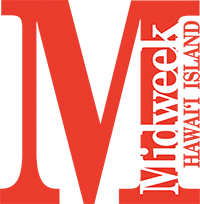Blazing A Trail
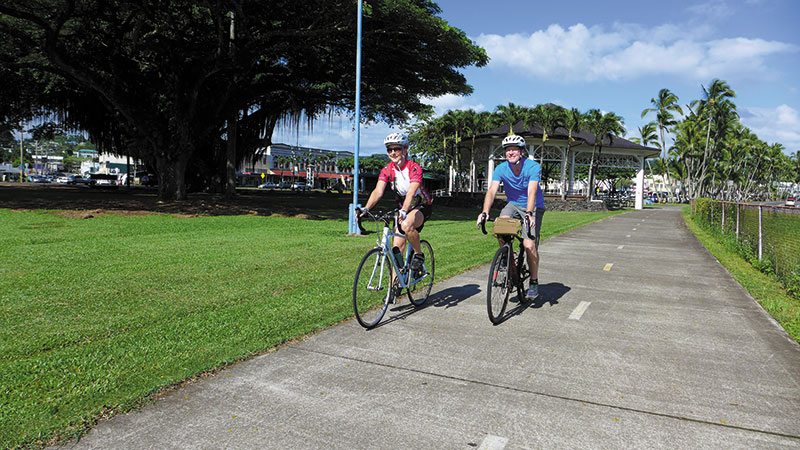
Hilo Bayfront Trails treasurer Amy Self and board member Christian Engelhardt ride along the path. KATIE YOUNG YAMANAKA PHOTO
Whether used for health and fitness or cultural celebration, the shared-use pathway Hilo Bayfront Trails has been a source of pride for the town’s residents and visitors.
You may have seen them down there — little sibs on scooters and skateboards, kūpuna walking with friends and the pau hana crowd opting for a late afternoon jog. On the weekends, there are entire families on bicycles or strolling along Hilo Bayfront Trails.
The shared-use pathway throughout the Bayfront area and Hilo Harbor — which will ultimately feature nearly 6 miles of trails connecting over 700 acres of land with dedicated bicycle lanes, pedestrian sidewalks and multimodal paths — will begin construction of Phase 2 in early 2020 to complete the soccer field loop. Phase 1 (from Mo‘oheau Bandstand to the canoe hale near the Iron Works building, and a loop around the mauka soccer fields at Bayfront) was completed in 2015.
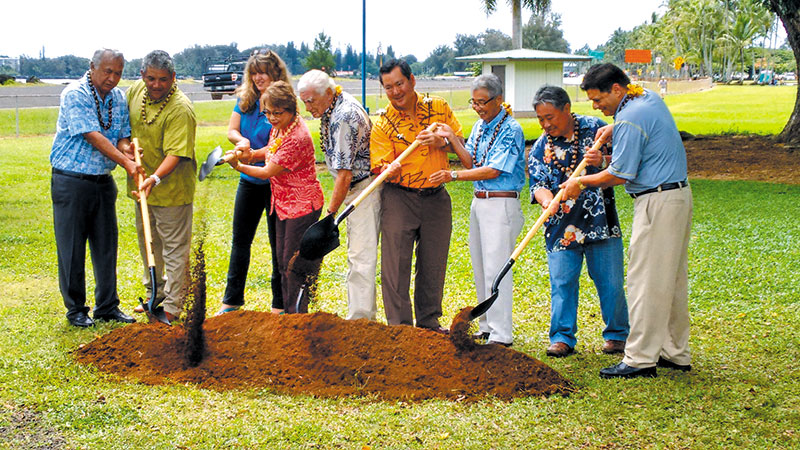
Pictured at the Hilo Bayfront Trails groundbreaking are (from left) the late state Sen. Gilbert Kahele, former Mayor Billy Kenoi, Hawai‘i Island Contractors Association’s Caroline Loe~ er, state Sen. Lorraine Inouye, major project donor Edmund Olson, Hilo Bayfront Trails president Peter Kubota, the late state Rep. Clifton Tsuji, and Councilmen Dennis Onishi and Danny Paleka. PHOTO COURTESY KT CANNON EGER
“The trail is a much-needed asset to our town, allowing increased accessibility around our local parks and Bayfront areas,” explains Hilo Bayfront Trails president Peter Kubota. “We envision the trail as a pathway to not only showcase the natural beauty of our Hilo hometown, but also to improve (our citizens’) health and fitness, as well as aid in historic preservation, cultural celebration and a sense of pride in our community.
“It’s a trail where kūpuna can linger and talk story with friends, mothers can stroll with their keiki, visitors can explore and sightsee, and others can enjoy running, biking, walking and more. We are building a trail that will make our town proud!”
Phase 1 is already getting lots of use from parents waiting for their children at soccer practice, after work walkers and families enjoying sunny weekend days.
“Phase 2 is in design engineering,” says Kubota. “It adds a path connecting the soccer pavilion to the Ponahawai/Kīlauea Street corner, and completes the soccer loop around Waiolama Canal.”
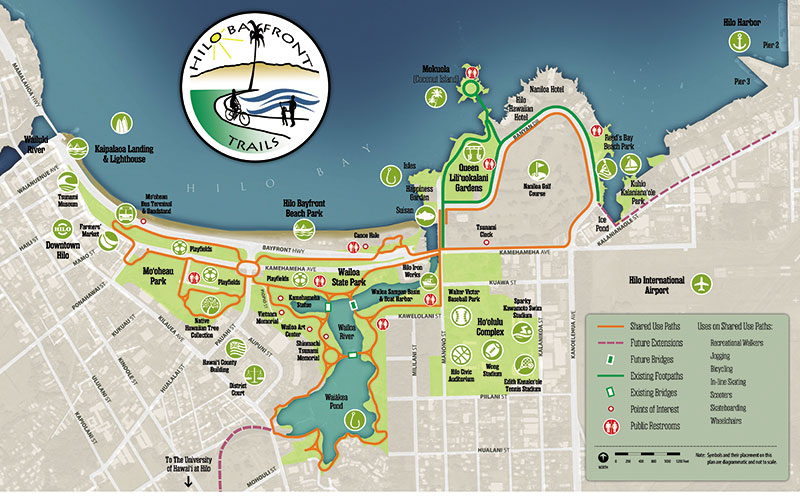
A map of Hilo Bayfront Trails’ master plan shows an overview of the site. PHOTO COURTESY HILO BAYFRONT TRAILS
Kubota adds that under the state parks department, the Wailoa State Park section of the trail — as well as the pavilion and parking improvements — are also almost ready to begin. They will connect the Wailoa small boat harbor to the pavilions and beyond (toward Waiākea Villas).
“Public projects take longer than you would expect, but we will get this trail completed and connected, section by section, as funds become available,” says Kubota.
The first phase was completed with a combination of backing from a federal Land and Water Conservation Fund grant, private donations, and county Parks and Recreation support.
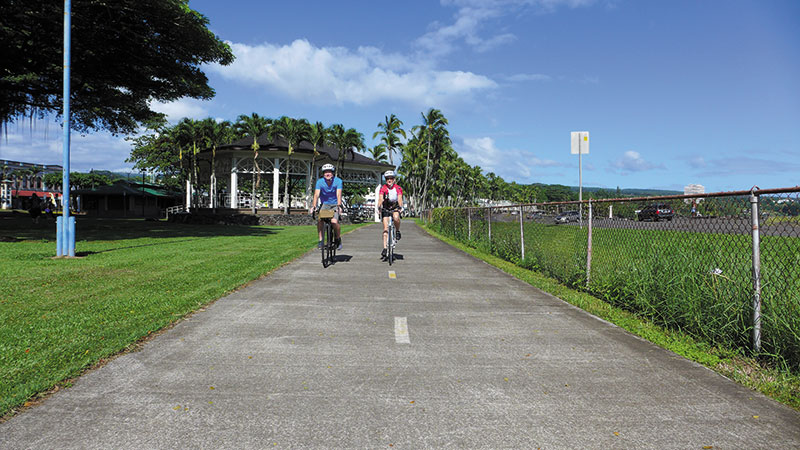
“Phase 1 cost a little over $1 million to complete,” says Kubota. “We have a second grant in place for Phase 2, along with funds from the Edmund Olson Trust and pledges from other local businesses. We have received many individual/private contributions as well. And any donors giving $500 or more can have their names etched into a 12-foot-by-12-foot concrete section of the trail.”
Kubota, who had the vision for the trails, feels that the Hilo Bayfront area and Wailoa State Park offer the most beautiful views in the state.
“It’s right in front of us, but we rarely make the time to enjoy its beauty. I attended the University of Oregon in Eugene in the early ’80s, and I often rode a bike/pedestrian trail from campus to Valley River Center, a shopping center, which was about a 7-mile round trip. It was a beautiful trail along the Willamette River — far from roads and vehicular traffic.
“I often dreamed from that time of establishing a trail system in and around Wailoa State Park,” he continues.”I thought it could be even more beautiful with views of Mauna Kea, Mauna Loa, the tranquil water and the arched bridges of Wailoa Pond.”
Kubota hopes the trail will entice and inspire residents and tourists to walk or ride the trail and enjoy what Hilo has to offer. BIKI bike rental stands have recently been installed at key areas along the trail, too, as an option for trailgoers who would prefer to ride instead of walk.
“The reason I like trails is because they take you away from the cars, which are very dangerous,” says Amy Self, Hilo Bayfront Trails treasurer and retired deputy corporation counsel for the county. “It’s not just important for bikes, but it’s a path for walking, too. I take walks with people at lunchtime. I did it while I was working and I do it still.
“This was an important project for me because I love biking and I’ve biked all over. Hilo was in need in something that would give people a safer environment to do these kinds of activities.”
Hilo Bayfront Trails board member Christian Engelhardt agrees.
“I’m an avid biker and athlete and I like being outside,” he says. “I’ve been in Hilo 17 years, but I grew up in Germany where biking was a part of life. I realized here, everything is very car-focused. But I think people still like the outdoors, so finding a middle
ground … and when I found out about the trails I was totally in support of this. I use the portion of the trails that has been completed already to commute from work, and on the weekends, myself, my wife and my daughter use it as a family to bike down to Lili‘uokalani Park. I think so far this has been of great value to the community.”
This trail, once completed, will connect Banyan Drive with downtown Hilo and will have vistas and serene pockets in and around Wailoa State Park, says Kubota.
“It will be an easy path for visitors, too, with signs and historic markers to educate about Hilo Bayfront’s history,” he adds.
“We are planning future sections around Banyan Drive and up to the University of Hawai‘i, too,” says Kubota. “Families with children and kūpuna will use the trail for generations, long after we are gone, and it will help to tie our community together. It will be a place where people gather and meet each other while getting exercise, away from street traffic.”
For more information, visit hilobayfronttrails.org.
